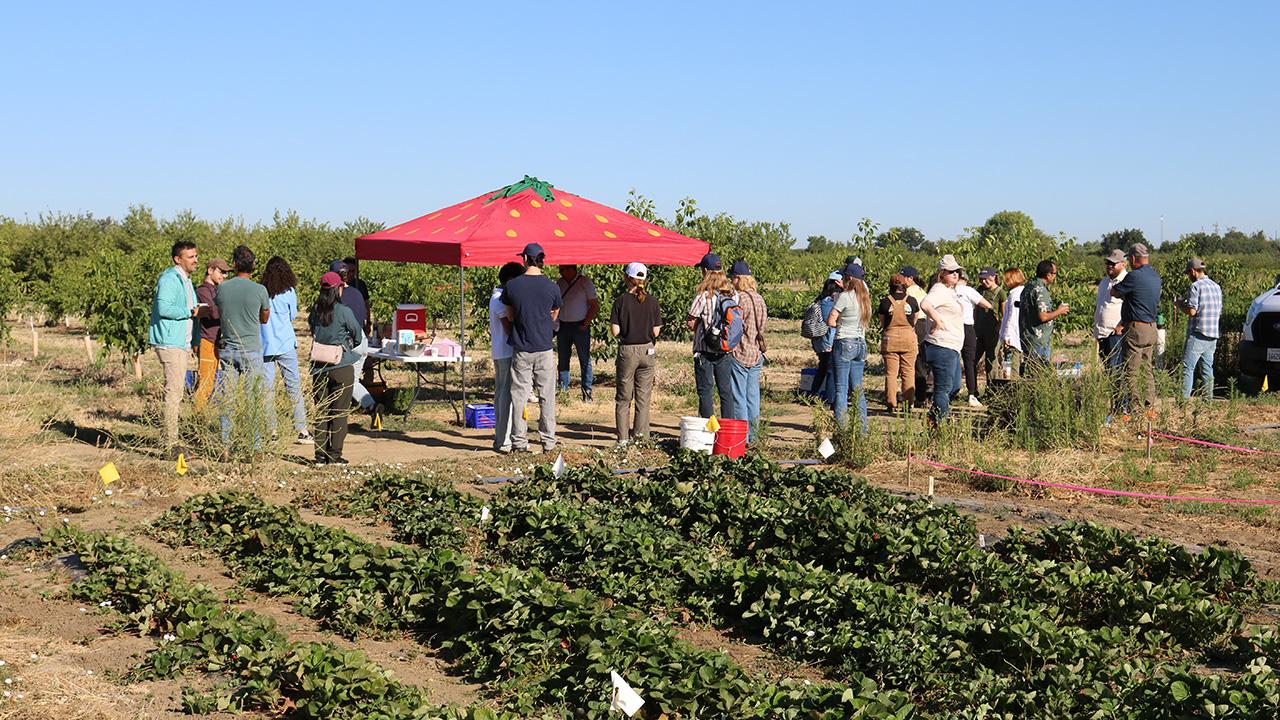Davis, California, USA
July 15, 2024
 Visitors to UC Davis Strawberry Disease Field Day learned about efforts to reduce problems in the field and after harvest, for both strawberries and tomatoes. (Andrew Rader/UC Davis)
Visitors to UC Davis Strawberry Disease Field Day learned about efforts to reduce problems in the field and after harvest, for both strawberries and tomatoes. (Andrew Rader/UC Davis)
In California, strawberries bring in more than $3 billion yearly, according to the California Strawberry Commission. They rank third in farm gate value among all fruits produced in the entire United States, according to the U.S. Department of Agriculture. Globally, the economic impact of these luscious bites is even more.
Diseases in the field and after harvest cut into that economic engine, making research at UC Davis to fight those losses all the more valuable. Advances in breeding and postharvest handling to reduce those costs were on display at the recent Strawberry Disease Field Day, hosted by the UC Davis Strawberry Breeding Program.
Scientists also discussed their research into diseases affecting tomatoes, breeding of resistant varieties and how growers can reduce infection.
The event was held June 28 at the Armstrong pathology fields at UC Davis, showcasing research done by the group led by Steven Knapp, program director, and Mitchell Feldmann, and by the Blanco-Ulate and Swett labs. This is the second year the strawberry program has hosted this event. Visitors listened to short talks from researchers and breeders, then enjoyed coffee and donuts, discussions over posters and careful forays into ongoing disease experiments.
Incorporating disease resistance into breeding efforts
Strawberry breeder Glenn Cole led the strawberry presentations. He explained how the Strawberry Breeding Program has used field experiments with diversity panels and advanced breeding lines. They seed to, first, understand the genetic basis of how strawberry plants can hold off diseases in soil; and second, use that knowledge to ensure newly released varieties contain the best disease resistance available.
This work is key for some of the diseases threatening strawberry production, including the ubiquitous Macrophomina phaseolina. A recent report from the lab described breeding success against this pathogen.
Other strawberry talks highlighted ongoing research projects, including resistance to two strains of Fusarium wilt, viral diseases and post-harvest pathogens.
 Saskia Mesquida Pesci, left, and Adrián Sbodio discuss research to minimize post-harvest disease in a range of fruits. They're from the lab of Bárbara Blanco-Ulate. (Andrew Rader/UC Davis)
Saskia Mesquida Pesci, left, and Adrián Sbodio discuss research to minimize post-harvest disease in a range of fruits. They're from the lab of Bárbara Blanco-Ulate. (Andrew Rader/UC Davis)
Post-harvest disease
Adrián Sbodio and Saskia Mesquida Pesci discussed novel approaches for assessing postharvest infections of persistent fungal pathogens from the lab of Bárbara Blanco-Ulate, in the Department of Plant Sciences. They discussed new protocols developed in the lab, including one using multispectral imaging to identify infected fruit before lesions are evident. Symptoms can be found on diseased fruit earlier using this technique, and it may facilitate removal of contaminated fruit to prevent further disease spread throughout the postharvest supply chain.
This spread from infected to healthy fruit was the focus of the second talk, which presented recently published work on a contact-based, fruit-to-fruit inoculation protocol. This protocol, tested in many different fruits, allows researchers to survey how postharvest conditions can affect the spread of disease in conditions similar to those fruit may encounter on their way to a grocery store.
A tomato (rot) field trip
 Tomatoes growing in the UC Davis Armstrong pathology fields. (Andrew Rader/UC Davis)
Tomatoes growing in the UC Davis Armstrong pathology fields. (Andrew Rader/UC Davis)
Visitors walked down to a neighboring field for the end of the event, where Myles Collinson, from the lab of Cassandra Swett, discussed a newly emerging fungal crown and stem rot disease of processing tomatoes.
This is a new line of research. Collinson said. He discussed efforts to understand which tomato varieties are susceptible, which fungal species are driving disease and how crop rotations can reduce or worsen infection. Visitors enjoyed a handout and in-person dissection showing symptoms in a tomato stem.
Highlighting research at Armstrong pathology fields
Visitors to the field day came from several UC Davis department labs as well as UC Cooperative Extension, Foundation Plant Sciences and local companies.
“We are really proud of the work we do at Armstrong,” said Dominique Pincot, one of the organizers of the event. “We were excited to share our approach and results, but we were also curious about the fields of our neighbors. We were really happy this year to be able to hear from and share ideas with other disease researchers at Armstrong and on campus.”
“We hope to keep holding this event in the future,” said Randi Famula, another organizer and lab manager for the strawberry breeding program. “So, if you have any experiments at Armstrong, hopefully we can hear from you, too, next time!”